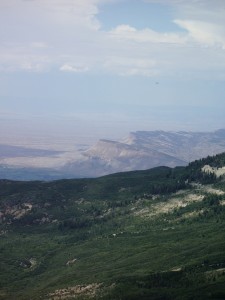I am an advocate of U.S. road trips as a cost-effective and adventurous way to spend one’s summer vacation. One of my favorite things to do while I’m on the road is to enjoy the variety of “natural wonders” the U.S. has to offer. Here are some of my top picks for you to check out the next time you find yourself on the road and in search of some natural beauty. Many lodgings in these areas fill up quickly for the summer months, so I recommend planning your natural getaway in advance.
Grand Canyon National Park (North Rim), Arizona
Grand Canyon National Park, visited by more than five million people each year, is considered one of the seven natural wonders of world and is a World Heritage Site. The North Rim of the Grand Canyon is much less touristy than the South Rim, which is why I prefer it. During the summer months rooms are hard to come by at the Grand Canyon Lodge (they bill themselves as the only lodging on the North Rim, however there are some smaller options nearby), so book early if you’re interested in staying here. The North Rim features exposed geologic formations from the earth’s four eras of geologic history. Information at look-out spots and the North Rim Visitor’s Lodge teaches visitors about the formation of the Canyon (it was carved by the Colorado River over a period of six million years) and biological diversity.
Carlsbad Caverns National Park, New Mexico
Since I first visited them as a kid I’ve been enthralled with the Carlsbad Caverns, over 117 underground caves that were formed when sulfuric acid dissolved the surrounding limestone. The well-designed visitor’s center provides information on these unique geological formations as well as schedules for the variety of cave tours available. Whatever you do, make sure you’re at the “bat cave” at dusk where you can watch hundreds of Mexican free-tail bats fly out of the cave and over your head.
Redwood National Forest, California
Redwood National Forest is comprised of the official Redwood National Park and Redwood State Park and located in northern California. It runs along 37 miles of northern Californian coastline. Of course, the Redwood National Forest is best known for its “stars,” massive redwood trees (in height and girth) that cause most visitors to drop their jaws. However, this diverse ecosystem is also home to expansive prairies, oak forests and over 35 miles of savage coastline. The forest is also a protective area for various threatened species including the Northern Spotted Owl, Brown Pelican, Tidewater Goby, Bald Eagle, Steller’s Sea Lion, and the Chinook Salmon.
Yosemite National Park, California
Located in the Sierra Nevada mountain range of Central California, Yosemite National Park encompasses a variety of breathtaking sights including waterfalls, valleys, meadows, and giant sequoias. The park spans 1,170 square miles and ranges in altitude from 2,000 feet to over 13,000 feet above sea level. Nearby cities include San Francisco, Los Angeles and Reno.
Grand Mesa, Colorado
The area commonly referred to as Grand Mesa is a combination of the Grand Mesa, Uncompahgre and Gunnison National Forests, all located on the western side of the Colorado Rockies, an area that lies south of the Colorado River and west of the Continental Divide. The three forests together span over 3,161,912 acres and vary in elevation from 5,800 feet above sea level (in Roubideau Creek Canyon) to 14,309 feet (on Uncompahgre Peak). Highlights include Bridal Veil falls, the over 300 lakes in the Grand Mesa, and the Alpine Tunnel.

